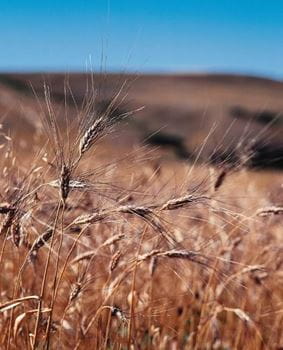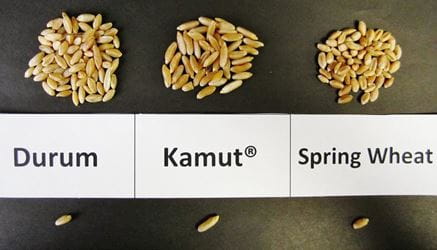Khorasan wheat (Triticum turgidum, ssp. turanicum) is an ancient wheat variety that originated in the Fertile Crescent in Western Asia. It is a relative of durum wheat and is believed to have come to North America from Egypt, following World War II. It was rediscovered in 1977 by a Montana farmer who spent the next few years propagating the small supply of original seed. In 1990, khorasan wheat was first sold under the trademark KAMUT® in the United States. The trademark was implemented to preserve minimum standards for the khorasan wheat variety and to ensure consistent quality and market supply. KAMUT® wheat is currently only grown as an organic certified grain and marketed to various countries around the world.
Plant Adaptation

kernels than hard red spring wheat and durum.
Photo courtesy T. Blyth, Kamut International
KAMUT® wheat production is well suited to growing conditions found in southern Alberta and southern Saskatchewan, similar to durum. Northern regions with cooler, wetter conditions are less favourable for KAMUT® wheat production as disease risk may be greater and the crop requires about 100 days to mature after seeding or approximately one week later than spring wheat. KAMUT® wheat will grow well in any soil that is suitable for other cereal grain production.
KAMUT® wheat has a growth pattern similar to spring wheat varieties. Each sprouted kernel produces one or two stems per seed, and each stem produces a large head with long black awns. It has moderate straw strength and grows to approximately 127 cm (4.2 ft) tall. Heads will bend over when mature, which helps shed rainfall and reduces the risk of sprout damage. This wheat variety is resistant to bleaching and the hull protects it from shattering loss. There are approximately 25 to 35 kernels of grain per head, and the kernels are roughly twice the size of spring wheat and have a distinctive hump shape.
Crop Management
KAMUT® wheat produces well in diverse organic rotations that are designed to interrupt disease, insect and weed cycles. Similar to other cereals, it yields well after a fallow or green manure plough-down that provides nitrogen fertility into the crop system. Green manure plough-downs also help minimize in-crop weed competition and volunteer cereal crops in the KAMUT® grain.
Seeding
Seeding KAMUT® wheat should be done in the first two weeks of May using a row spacing between 15 to 23 cm (6 to 9 inches). The narrower spacing will help the crop canopy close in more quickly to help compete with weed growth. The recommended seeding depth is 1.9 to 5 cm (3/4 to 2 inch).
The bushel weight is similar to wheat at 60 lbs/bu. The target plant density is similar to other wheat varieties, ranging from 210 plants/m2 (20 plants/ft2) for durum to 250 plants/m2 (24 plants/ft2) for hard red spring wheat. Typically, wheat varieties with a larger seed size are sown at higher rates to maintain the correct plant stand density. Higher seeding rates are often used in organic systems to provide the wheat crop with a competitive advantage against weeds, particularly if soil moisture and fertility conditions are favourable. As with other cereal crops, it is important to seed into soil moisture and drill press wheels will help establish good seed to soil contact.
It is strongly recommended that seeding rates are determined on the basis of intended plant density, thousand kernel weight (TKW) and the per cent survival (percentage of seeds planted that germinate and emerge into vigorous seedlings).

Photo courtesy Prairie Heritage Seeds Organics Inc.
The following formula provides an approximate seeding rate calculation.
Seeding rate (lb./ac.) = plants per sq. ft. x TKW (g) x 10 (conversion factor*) ÷ per cent survival (*The conversion factor is used to convert to appropriate units.)
The seeding rate calculator available on the Alberta Agriculture and Forestry website also provides an easy method to determine appropriate seeding rates.
Pest Management
It is not recommended to seed KAMUT® wheat into a field with strong weed competition as it does not tiller out as much as other wheat varieties, resulting in slower crop canopy development and increased weed pressure. Similar to other cereal crops in organic systems, pre-seeding, pre-emergent and post-emergent weed management can be very effective at minimizing yield loss due to weeds. For more information about weed control in organic systems, refer to the Organic Crop Production Weed Management.
Similar to other wheat varieties grown on the prairies, KAMUT® wheat may be susceptible to disease infections if field conditions remain humid for a prolonged period of time or rainfall is frequent. Common fungal diseases include leaf spots such as tan spot and rusts, or root rots. Excess moisture received in the last 30 days of the growing season may result in infected heads. Diseased kernels will appear weathered and discoloured, black- pointed or smudged, and may have reduced marketability.
KAMUT® wheat is susceptible to the same insect pests as other wheat varieties. Particular insects that can cause significant economic damage in peak cycle years include wheat midge and grasshoppers.
Harvest and Storage
It is important to handle KAMUT® wheat carefully during harvest. The crop is swathed at 18 per cent moisture (milky dough stage), with 12.5 to 13.5 per cent as the target final moisture content. Harvesting the grain at slightly higher moisture (tough) and then aerating it to the final storage moisture content may help reduce broken kernel losses.
The target for broken kernels is five per cent or less. This is possible with a conventional combine. Rotary combines may be able to achieve three per cent or less with the proper settings. An easy way to evaluate your combine settings and adjust for broken kernels is to fill a 250 ml (eight oz.) cup and count the broken kernels; four per cent broken kernels is approximately 10 ml (2 tsp.) of the total.
Careful grain handling after harvest will also help minimize broken kernels and dockage. Operate augers at full capacity and at slower speeds to reduce cracked and broken grain. Peas and lentils are not difficult to clean out of the grain; however, wild oats can be difficult to remove.
Yield Potential
KAMUT® wheat yields are lower than spring wheat varieties under normal growing conditions. Crops may yield as high as 2,017 kg/ha (30 bu./ac.) in ideal conditions, and average yields in southern Saskatchewan are around 1,681 kg/ha (25 bu./ac.).
Marketing and Utilization
KAMUT® wheat is trademarked wheat that can only be marketed as such if it has been grown on certified organic farms, and is exclusively grown under full production contracts with KAMUT® Brand wheat buyers. Cleaned grain is shipped to export markets in bags and bulk, and the primary buyers are pasta and bread manufacturers. Canada is a primary exporter of KAMUT® Brand wheat, globally. Italy is a major importer. As it is a trademarked system guaranteeing certain quality standards, KAMUT® Brand wheat buyers are directly involved with growers through all stages of crop production.
The buyers currently located in western Canada are Prairie Heritage Seeds (P.H.S.) Organics Inc. and Artesian Acres. P.H.S. Organics is the buyer for all KAMUT® Brand wheat marketed to Europe and Artesian Acres is the buyer for all KAMUT® Brand wheat that is sold in Canada.
Market demand for KAMUT® wheat has grown over the past few years. KAMUT® wheat attributes include a mild, nutty flavour, and a high protein, lipid and mineral (selenium, zinc, magnesium) content.
For more information relating to the KAMUT® wheat nutritional profile, refer to the Kamut International Ltd.
For more information, contact:
Prairie Heritage Seeds Organics Inc.
(P.H.S. Organics), PO Box 457, Radville, SK, S0C 2G0
Phone: 306-869-2926, Fax: 306-869-2750
Email: info@phsorganics.com
Artesian Acres
PO Box 336, Fort Qu’Appelle, SK, S0G 1S0
Phone: 306-332-6818, Fax: 306-332-6580
Email: artesian@sasktel.net
Reference:
A Guide For Growing KAMUT® Khorasan Wheat
March 2011
Available from Montana Flour & Grains, PO Box 517, Fort Benton, MT 59442
Phone: 406-622-5436
